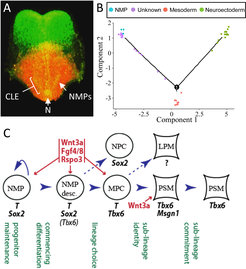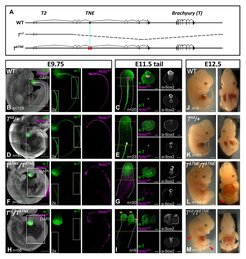Genetic control of trunk development in the mouse
The trunk and tail develop by continuous elongation of the anterior body anlage, which gives rise to the head and neck. This elongation process is controlled by a caudal structure, the primitive streak followed by the tailbud, which act as growth zone in which stem and progenitor cells are constantly producing descendants contributing to the different lineages.
Three major cell lineages are generated during trunk formation and give rise to all the tissues and organs. These are the mesoderm, the neuroectoderm and the endoderm. The mesoderm derivatives generate most tissues of the trunk, they form e.g. the skeleton, skeletal muscles, limbs, body wall, blood vessels, kidneys, gonads, and smooth muscles. The neuroectoderm forms the spinal cord, and the endoderm the mid- and hindgut.

The neuroectoderm and mesoderm are derived from neuro-mesodermal progenitors (NMPs), a cell type with limited self-renewing capacity. NMPs are controlled by Sox2 and Brachyury, transcription factors that are essential for neural and mesodermal development, respectively. The self renewal of NMPs depends on an auto-regulatory feedback loop between the secreted inducer molecule Wnt3a and Brachyury. This gene pair constitutes the key control module for trunk and tail development. Together they control progenitor cell maintenance, axial elongation, mesoderm formation and initial dorso-ventral patterning of generated tissues.
NMP cell division generates descendants allowed to undergo differentiation to produce the tissues of the trunk. These early descendants undergo the lineage choice determining their fate towards the spinal cord or the mesodermal tissues. This lineage choice is characterized by antagonistic activities between Sox2 and Brachyury, in which each factor upregulates control factors of their own lineage and represses the control factor of the competing lineage. The large majority of NMP descendants is dominated by WNT signalling and Brachyury, and thus choose the mesodermal fate. Mesodermal cells undergo further lineage decisions towards paraxial, intermediate or lateral fates. The paraxial fate choice giving rise to the axial skeleton and skeletal muscles is controlled by WNT signalling together with its target transcription factors Brachyury, Tbx6 and Msgn1.
The lateral fate choice is less well understood und currently under investigation in our laboratory.
We have investigated the control of brachyury in the node, notochord and tail bud NMPs and identified several enhancers that are essential for notochord development and axial elongation. We have published one notochord enhancer and its role in axial elongation recently. Our next goal is to provide a deeper insight into the trunk organizer, lateral mesoderm development, tail NMP formation and tail outgrowth.


